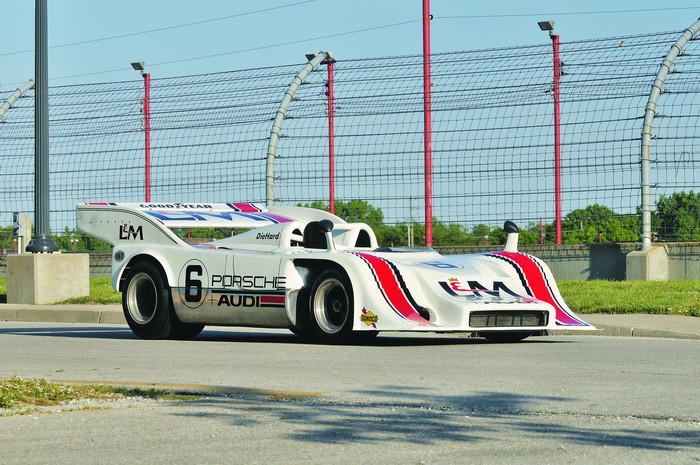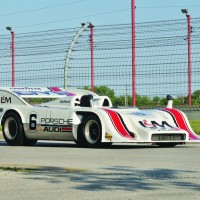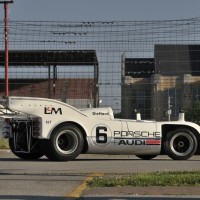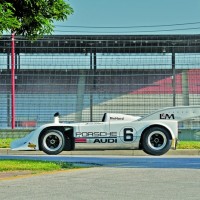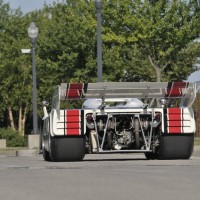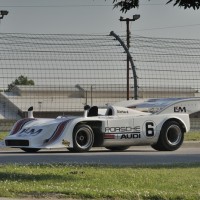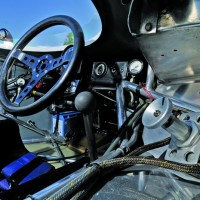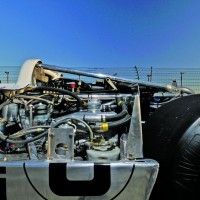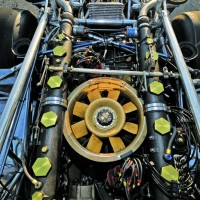- Team Penske Racing, sponsored by L&M
- Driven by racing legends Mark Donohue and George Follmer
- Debuted at Mosport ’72 Can-Am driven by Mark Donohue
- Dominated the ’72 Can-Am series, taking first at five of nine races
- Can-Am Champion in ’72 driven by George Follmer
- Raced as #6 by Donohue and #7 by Follmer in ’72
- Penske then sold 003 to Rinzler and it was cam- paigned as the #16 car in RC Cola livery for the ’73 Can-Am season
- Second place overall in ’73 driven by George Follmer
- Powered by a 5.4L Twin Turbo 12-cylinder engine
- Capable of making over 1,150 horsepower, 0–100 mph in 2.9 seconds
- A true icon for automotive racing history
- This car earned Porsche their first Can-Am Championship and is one of the most significant race cars ever built
SCM Analysis
Detailing
| Vehicle: | 1972 Porsche 917/10 Spyder |
| Number Produced: | 14 |
| Original List Price: | $78,000 |
| Chassis Number Location: | Tag on frame, right side of engine compartment |
| Engine Number Location: | On block near rear distributor |
| Club Info: | 917 Chassis Registry |
| Website: | http://962.com/registry/917 |
| Alternatives: | 1968 McLaren M8, 1968 Ferrari 612, 1971 Shadow Can Am |
This car, Lot S123, sold for $5,830,000, including buyer’s premium, at Mecum’s Monterey auction on August 18, 2012.
In the Old Racing Car business, you will find that all of the permutations that combine “great to drive” and “excellent to collect” are filled — along with a few niches that are surprising but very real.
You can find a racer that is fabulous to drive — but with almost no collector value, such as a Dolphin or Bobsy sports racer. You can find a racer that will make your friends green with envy — but is a miserable thing to drive, such as a Ferrari 340 Mexico. Or you can find a combination of ultimate everything, such as a Ferrari 250 GTO or a Porsche 917K.
The turbocharged Porsche 917s are a different and surprising category. They have become very collectible over the past few years, and they may or may not be great to drive — but the point is that nobody dares find out. The Porsche 917/10 and 917/30 are probably the most dangerous sports racing cars that have ever been built, and the few drivers who are good enough to hang on to them tend to know better than to try — or can’t afford to risk trying.
Thus, these cars have become “obligate static” racers, seldom if ever actually driven. In short, they are prom queens lusted after — but not dated.
A fast history
The Porsche 917 story is well enough known that we don’t need to spend much time with it here. Porsche conceived and built the 917 to take advantage of a three-year loophole that the FIA had unwittingly built into their racing category rules. In an attempt to slow cars down from what were considered unsafe power levels during the Ford-Ferrari wars of the mid-1960s, the FIA mandated a 3-liter limit for the prototype cars that composed the top tier of racing at the time.
To fill up the grids during a 1969–71 transition, the FIA allowed a second category of “production” racers that were allowed a 5-liter engine with a 50-car minimum production, with Lola T-70s and Ford GT40s as examples. This, unfortunately, left out desirable cars with lower production, such as the Porsche 910 and Alfa Romeo T-33, so the FIA decided to lower the production requirement to 25 cars. At this point Porsche saw the opportunity and grabbed it, making history in the process.
Roaring through a loophole
Although it was never the FIA’s intent, Porsche realized that all they had to do was build 25 cars and they could use a 5-liter engine in their racers. By adding four cylinders to their 3-liter, 8-cylinder 908 engine, they could end up with a 4.5-liter flat 12 without spending too much on engine development. They had chassis designs available, so the idea wasn’t all that difficult to accept.
Having made the decision to proceed with their 917 project, the big problem was keeping it a secret while they built the requisite 25 examples. History shows that they were successful, and the competition (Ferrari, mostly) was caught with its pants down. After Porsche resolved some terrible aerodynamic issues with the initial body shape, the 917K became one of the most dominant endurance racers in the post-war period.
The important point in today’s discussion is that Porsche did all this with the full knowledge that it was a two-year window: It started in 1969 and the exemption was to end with the 1971 season, so 1970 and 1971 were all the time they had, at least for the European (FIA) races.
However, the United States was Porsche’s largest export market, and we had the wildly successful Can-Am series going strong, so creating a 917 variant to compete here was an obvious way to extend the franchise.
As opposed to the FIA’s arcane and complex rules for acceptable racers, the Can-Am rules were refreshingly simple: four wheels, two seats, bodywork that covers the wheels — go! Actually it was a little more complicated than that, but not much, as the whole idea was basically unlimited professional racing and they didn’t want rules to spoil the show.
With the development of ever-wider, stickier tires, Can-Am had quickly turned into a horsepower battle, dominated by up to 510-ci aluminum Chevy engines making well over 700 horsepower. So Porsche had a problem if they wanted to show well: their 302-inch flat 12 needed a boost. Turbocharging for automotive engines was not unknown in 1969, but it was a very new concept (GM tried it in 1962, and turbocharged Offenhauser engines first ran at Indy in 1966 and won there in 1968). Nobody had seriously tried to turbocharge a large-displacement road-racing car, but Porsche was willing to try.
Fighting the turbo lag — and power surge
Although they were wildly successful in generating horsepower and dominating the Can-Am, the Porsche 917/10s were extremely difficult to drive because of turbo lag and sudden boost.
Imagine yourself racing in a 917/10. You dive into a corner, all over the brakes and shifting down while the turbos more or less stop working. As you approach the apex, you crack the throttle and your 5-liter engine puts maybe 250 horsepower to the wheels; at the apex you squeeze on the power and get maybe 400 horsepower. As you exit onto the straight, you drop the hammer and get 500 as things start to work — and about one second later you’ve got 1,000 horsepower trying to find someplace to go, and you’re in the way.
This has been described as being like getting hit from behind by a truck, and even in the day, there were precious few drivers (Donohue and Follmer primarily) who were good enough to hang on. I personally know of two competent drivers in the vintage era who crashed badly when the boost got away from them — this is a car that will kill you.
Younger collectors want younger cars
For most of the time from then until now, their danger has rendered the 917/10 and sister 917/30 to be curiosities more than collectibles. They were considered undriveable old Can-Am cars — not collectible icons — but this is rapidly changing. Indeed, Porsche 917s have only developed serious collector value in the past five or six years. I have been watching the 917 market for at least 20 years, and for most of that time you would seldom see even a great one sell for more than maybe $1.5 million. Now any good 917K will be close to $10 million, and the 917/10s and 30s are trying to catch up.
I suggest that this represents a fundamental change in the nature of the collector-car market.
At Monterey this year, I was aware that the market for pre-war collectible cars seemed soft, with a number of serious examples failing or selling for short money, while 1950s and 1960s icons (some with less-than-great provenance) seemed to have a cloud of bidding paddles surrounding them. I think we have a new and much younger set of collectors entering the market, and they have limited interest in cars that were cool long before they (and sometimes their parents) were born. I am told that the average age of a Classic Car Club of America member is 73, and they aren’t getting younger. Their kids will drive the market in the future.
This bodes well for the great and iconic cars such as the Porsche 917, which until recently seemed too new to be seriously collectible. My contacts in the business assert that our subject 917/10 — as the best example of an ascendant marque and model — was well and intelligently bought, and I agree. The future seems bright for these cars. Just be careful if you take this one out onto the track. ?
(Introductory description courtesy of Mecum Auctions.)
